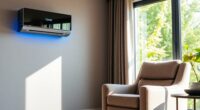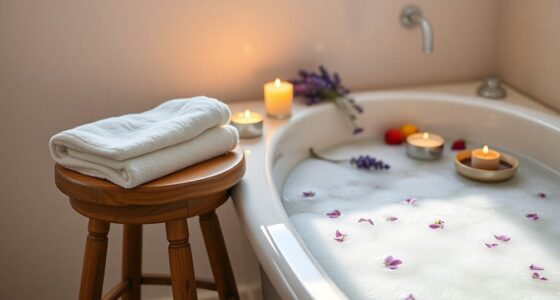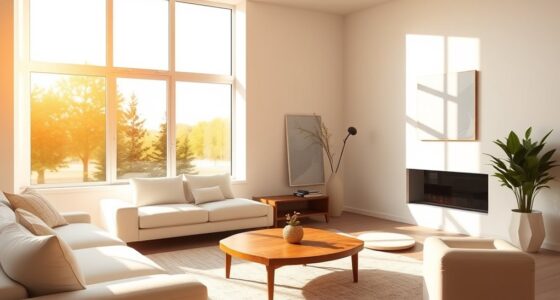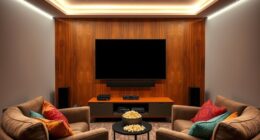To create a luxurious wellness experience in your spa, focus on thoughtful design and layout. Start with soundproof treatment rooms to ensure privacy and tranquility. Use ergonomic furniture for client comfort and maintain smooth traffic flow between wet and dry areas. Maximize natural light with large windows and warm ambient lighting to enhance mood. Don't overlook plumbing efficiency; it's crucial for smooth operations. Incorporate soothing colors and textures to create a cohesive atmosphere. With these elements, you'll elevate your clients' experiences. There's plenty more to consider to truly refine your spa concept and design.
Key Takeaways
- Prioritize soundproof treatment rooms to ensure privacy and tranquility for clients during their wellness experience.
- Design ergonomic layouts with adjustable furniture to maximize client comfort and relaxation during treatments.
- Incorporate natural light through large windows and skylights to create a serene, uplifting atmosphere.
- Enhance the ambiance with calming music, soothing colors, and high hygiene standards for an inviting environment.
- Plan efficient plumbing and waste management systems to maintain functionality and safety throughout the spa.
Budget Planning Strategies
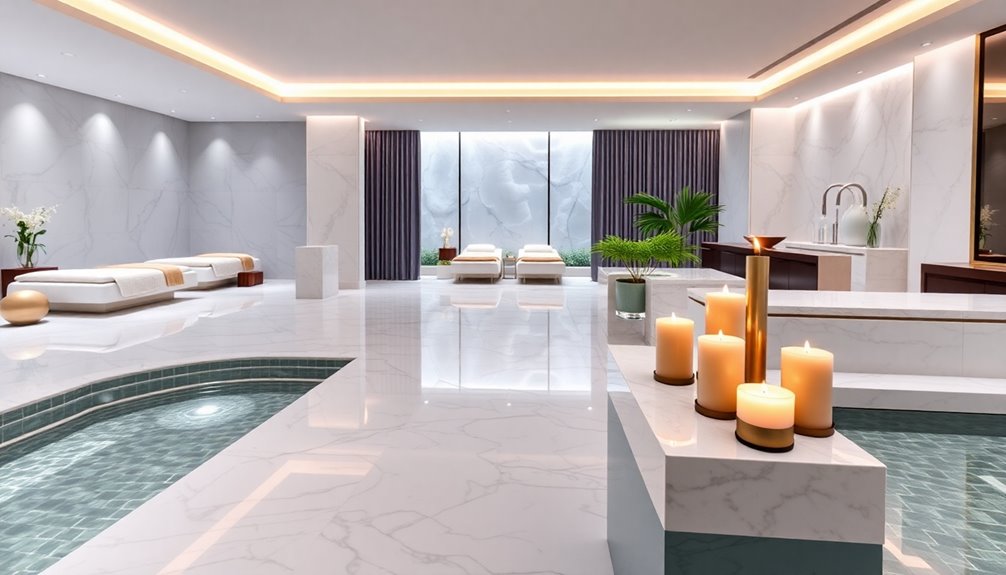
When you're planning a spa, budget planning strategies are crucial for long-term success.
Start by establishing revenue projections, forecasting income from services, product sales, memberships, and facility rentals. Use historical data and conduct market analysis to identify potential revenue streams.
Next, allocate expenses by identifying fixed costs like rent and salaries, along with variable costs such as supplies and marketing. Implementing a solid financial management strategy will help ensure that your spa maintains profitability.
Managing cash flow is vital; maintain a cash reserve for at least three to six months of operational costs and track monthly projections.
Lastly, regularly monitor and adjust the budget to adapt to market changes. By staying proactive with your financial strategies, you'll set a solid foundation for your spa's success.
Designing Treatment Rooms
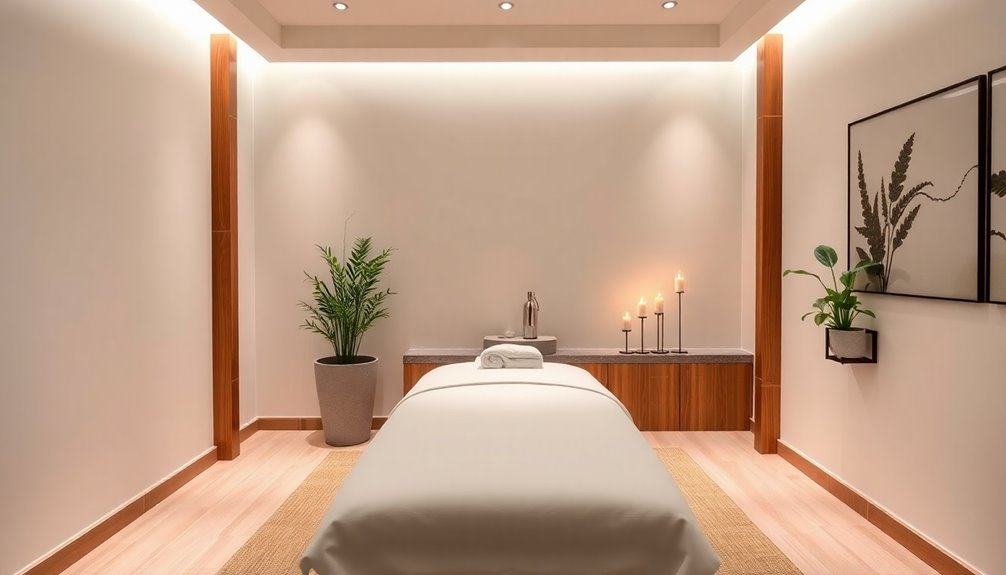
Effective budget planning sets the stage for every aspect of your spa, including the design of treatment rooms.
Prioritize privacy and tranquility by placing treatment rooms away from noisy areas, ensuring they're soundproofed for a peaceful experience. Maintain private access to minimize disruptions and uphold client confidentiality.
Incorporate ergonomic design with adjustable furniture and beds that support proper posture, enhancing comfort for both clients and practitioners. Additionally, consider plumbing simplicity to streamline installation and maintenance costs in the treatment room design.
Plan layouts for smooth traffic flow, distinguishing between wet and dry zones while ensuring accessibility for all clients.
Lastly, create a luxurious ambiance that aligns with your brand image, using soothing colors and textures to evoke relaxation.
Thoughtful design elevates your spa's experience and fosters client loyalty.
Enhancing Client and Staff Comfort
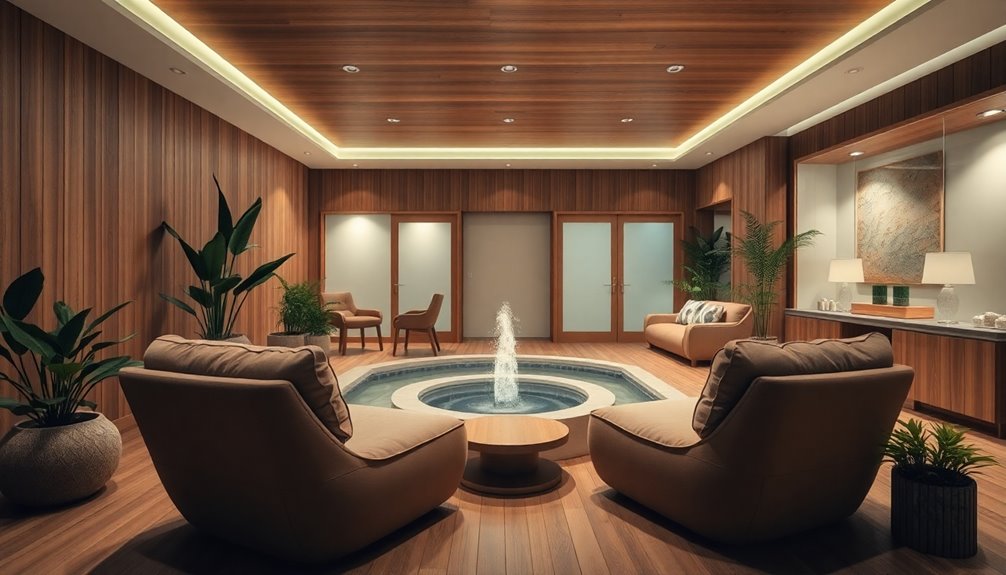
To create a truly enjoyable experience for both clients and staff, focus on enhancing comfort through thoughtful design and amenities.
Begin by incorporating calming ambient music and soundscapes, which help soothe minds and reduce stress. Ensure treatment rooms are soundproofed, allowing clients to relax without distractions. Additionally, offering healthy snacks and refreshments can further enhance the comfort and overall experience of clients during their visits.
Temperature control is essential—allow clients to customize their environment to meet individual preferences. Use natural elements, like wood and stone, to create a sense of warmth and connection to nature.
Prioritize privacy with well-designed treatment spaces that ensure clients feel secure and undisturbed.
Finally, maintain high hygiene standards throughout the spa, ensuring a safe and inviting atmosphere for everyone.
This approach fosters an exceptional experience, enhancing overall satisfaction and comfort.
Maximizing Natural Light
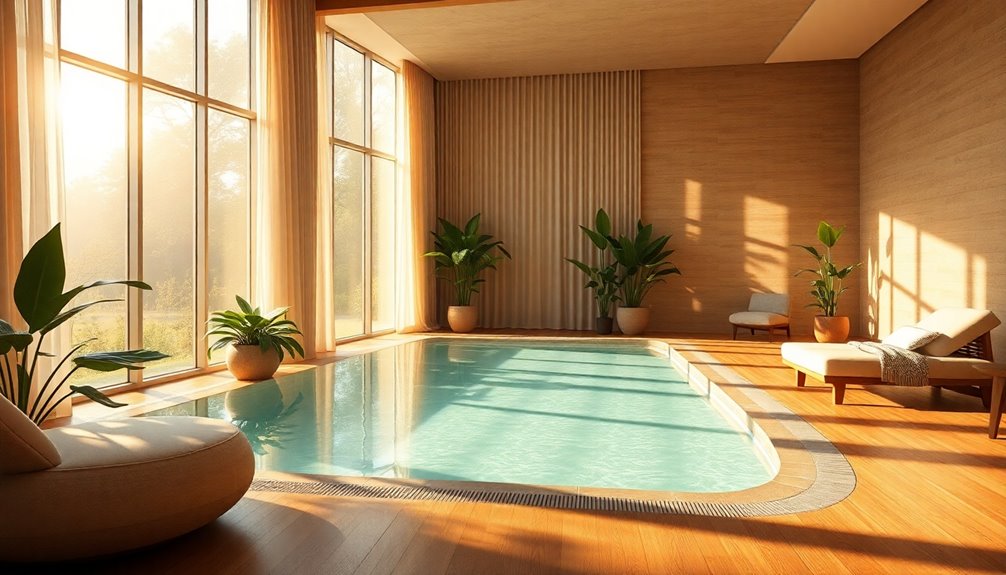
Maximizing natural light in your spa not only enhances the overall atmosphere but also contributes to clients' well-being.
Start by strategically placing large windows, skylights, and clerestories to invite sunlight in. Floor-to-ceiling windows on north and south walls can help maintain light balance, while custom shading on east and west sides prevents glare.
Reflective surfaces, like mirrors and polished finishes, can amplify light throughout your space, creating depth and spaciousness. Incorporate circadian lighting to mimic natural daylight cycles, promoting relaxation and improved mood. Additionally, leveraging natural light can support circadian rhythms, further enhancing overall wellness within the spa environment.
Use dimmable, warm-toned ambient lighting to adjust the mood in different areas. By combining these elements, you'll create a serene environment that supports holistic treatments and enhances the overall spa experience.
Plumbing and Waste Management

Creating a serene and inviting spa atmosphere goes hand in hand with a well-planned plumbing and waste management system. Start by using detailed 3D models to plan your plumbing, ensuring balanced flow and pressure at each therapy jet. Count every fixture accurately to minimize excess materials. Additionally, a detailed plumbing plan is essential to avoid improvisation and ensure a successful installation.
Simplify your setup with dedicated pumps for filtration, heating, and jets, and avoid heat bending PVC pipes to maintain hydraulic performance.
Incorporate primary plumbing lines around the spa's perimeter, allowing for structural strength while minimizing intrusions. Utilize high-quality systems like Shur-Grip for reliable connections, and ensure your jet pump has a large 3" air intake for efficient operation.
Finally, install anti-entrapment drains to enhance safety and functionality.
Ensuring Accessibility

While designing a spa, ensuring accessibility is crucial for creating an inclusive environment that welcomes all clients.
Start by placing people at the heart of the design process—engage diverse clientele to understand their needs. Incorporate flexible furniture and layouts to accommodate various abilities, like wheelchair-accessible seating.
Clearly distinguish between wet and dry zones to ensure smooth traffic flow. Provide accessible routes and multiple entry points, such as pool lifts and sloped entries.
Maintain a minimum clear deck space of 36 inches for easy transfers. Additionally, ensure that features like pool lift seats are appropriately designed for comfort and usability. Inclusive design enhances guest experience and well-being.
Creating a Cohesive Atmosphere

To achieve a cohesive atmosphere in your spa, it's essential to harmonize design elements that resonate with your overall vision.
Start by selecting a consistent color scheme and theme, ensuring that accessories like vases and rugs complement your choices. Use natural materials such as wood and stone to create warmth and texture throughout the space.
Clearly define wet and dry zones to maintain a smooth traffic flow, while providing relaxation areas with serene views. The layout of the spa significantly influences visitor perception and relaxation, so ensure that the arrangement promotes comfort.
Enhance the ambiance with dimmable lighting, calming soundscapes, and soothing scents. Incorporate natural elements like plants or water features, and choose elegant furnishings with soft lines.
These thoughtful details will transform your spa into a tranquil retreat where guests feel completely at ease.
Frequently Asked Questions
How Can I Incorporate Local Culture Into Spa Design?
To incorporate local culture into your spa design, start by using indigenous materials and showcasing local art.
Integrate traditional architectural styles and include elements that reflect the region's history.
Offer treatments that draw on local customs and rituals, educating clients about their significance.
Curate experiences that connect guests to the local environment, such as nature-based activities and local cuisine.
Always prioritize sustainability to respect both the culture and the surroundings.
What Are the Latest Trends in Spa Design?
When exploring the latest trends in spa design, you'll notice a strong emphasis on technology and wellness. AI-driven systems personalize experiences, while eco-friendly materials and energy-efficient designs are becoming essential.
You can also expect a focus on sleep optimization, with treatments aimed at improving your sleep quality. Additionally, integrating spiritual well-being through meditation and sensory experiences will enhance your relaxation journey, making your visit truly transformative and rejuvenating.
How Do I Choose the Right Materials for My Spa?
When you're choosing materials for your spa, it's crucial to consider durability, hygiene, and aesthetics.
Imagine stepping into a space where every surface resonates with luxury. You'll want to incorporate materials like marble for elegance and ceramic tiles for easy cleaning.
Don't overlook natural elements like wood for warmth, but remember the maintenance they require.
Finally, ensure your choices align with sustainability to create not just a spa, but a sanctuary.
What Technology Should Be Integrated Into a Modern Spa?
To create a modern spa, you should integrate advanced technologies like AI-driven treatments and wearable health monitors.
Incorporating virtual reality meditation can elevate relaxation, while robotic massage chairs ensure consistent experiences.
Real-time data integration lets you customize therapies based on individual needs.
Don't forget eco-friendly practices and immersive sensory environments to enhance the overall experience.
How Can Outdoor Spaces Enhance the Spa Experience?
Imagine stepping into a tranquil garden, the scent of blooming flowers enveloping you as you unwind.
Outdoor spaces can elevate your spa experience by connecting you with nature's beauty.
Picture open-air treatment rooms where gentle breezes carry away stress, or serene rooftop terraces offering breathtaking views.
Incorporating water features and lush landscapes enhances relaxation, making every moment feel like a retreat.
You'll leave feeling rejuvenated, with nature's calmness lingering in your soul.
Conclusion
In crafting your spa design, think of each element as a brushstroke on a canvas, combining to create a masterpiece of tranquility and luxury. By harmonizing treatment rooms, maximizing natural light, and ensuring accessibility, you're not just designing a space; you're cultivating an oasis of well-being. As you weave comfort and aesthetics together, you're inviting clients into a sanctuary where they can escape the chaos of the outside world and rejuvenate their souls.

